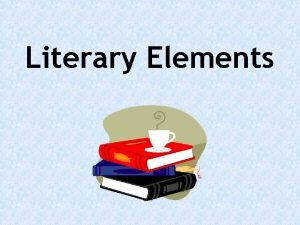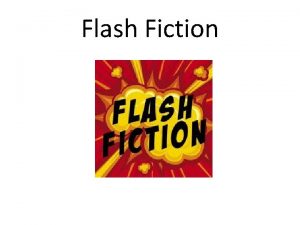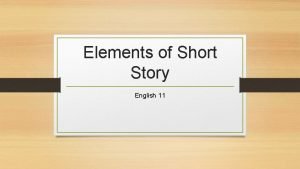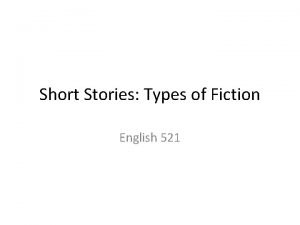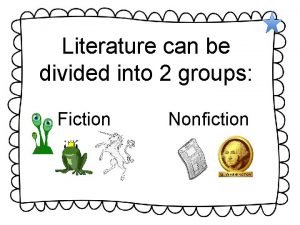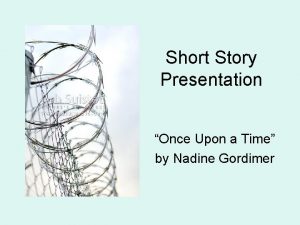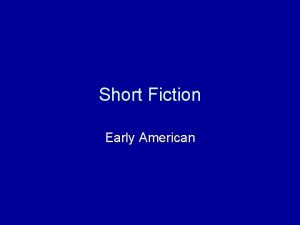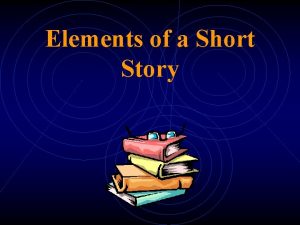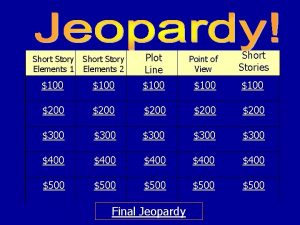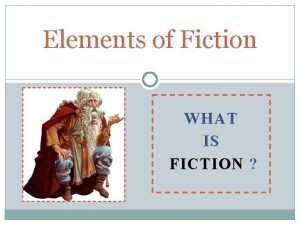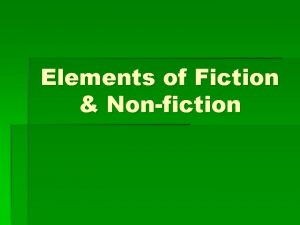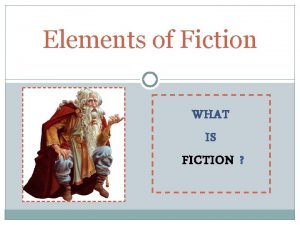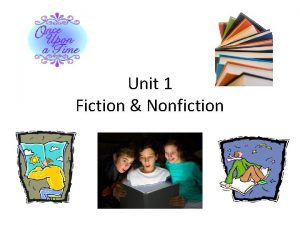Elements of a short story Elements of fiction











- Slides: 11

Elements of a short story Elements of fiction ØSetting ØCharacters ØPoint of view ØPlot Øconfilict ØTheme/ themes

Setting: The time and location in which a story takes place. . There are several aspects of a story's setting to consider when examining how setting contributes to a story: • a)Place-geographical location. Where is the action of the story taking place? • b)Time-When is the story taking place? (Historical period, time of day, year, etc) • c)Weather conditions-Is it rainy, sunny, stormy, etc? • d)Social conditions -What is the daily life of the characters like? Does the story contain local colour (writing that focuses on the speech, dress, mannerisms, customs, etc. of a particular place)? e)Mood or atmosphere-What feeling is created at the beginning of the story? Is it

Characters • Characters: The persons in a short story. Ø Major/main characters: he/she is central to the short story and makes events move. He/she is called the protagonist or hero/ heroine in some cases. The opposer is called the Antagonist ( They an be animete or inanimate: animals, objects) Ø Minor/ secondary charcters: They are not central to the story, but are there to help or tell something about the main characters. ( for example: Eveline’s father and dead mother, The mayor and councillors in The Happy Prince. Josephine, Richard and Mr. Mallard in the Story of an Hour)

Point of view • Point of view is defined as the angle from which the story is told. It can be: Ø First Person: The story is told by the protagonist or one of the characters who interacts closely with the protagonist or other characters (using pronouns I, me, we, etc). The reader sees the story through this person's eyes as he/she experiences it and only knows what he/she knows or feels. It is called a subjective point of view.

Ø Third person Objective point of view: The author tells the story in the third person. It appears as though a camera is following the characters, going anywhere, and recording only what is seen and

Plot is the way the author has arranged events in the short story to develop his idea. It is a plannaed logical series of events. There are five essential parts of plot: Øa)Background events: the beginning of the story where the characters and the setting are introduced. Ø b) Rising Action-This is where the events in the story become complicated and the conflict in the story is revealed (events between the introduction and climax). ØC) Climax -This is the highest point of interest and the turning point of the story. The reader wonders what will happen next; will the conflict be resolved or not? d)Falling action-The events and complications begin to resolve themselves

Ø d)Falling action-The events and complications begin to resolve themselves. The reader knows what has happened next and if the conflict was resolved or not (events between climax and denouement) Ø e)Denouement-This is the final outcome or untangling of events in the story. N. B: It is helpful to consider climax as a three-fold phenomenon: 1)the main character receives new information 2)accepts this information (realizes it but does not necessarily agree with it) 3)acts on this information (makes a choice that will determine whether or not he/she gains his objective).

Conflict is essential to plot. Without conflict there is no plot. It is the opposition of forces which ties one incident to another and makes the plot move. Conflict is not merely limited to open arguments; rather it is any form of opposition that faces the main character. Within a short story there may be only one central struggle, or there may be one dominant struggle with many minor ones. There are two types of conflict: 1)External-A struggle with a force outside one's self. 2)Internal-A struggle within one's self; a person must make some decision, overcome pain, quiet his/her temper, resist an urge, etc.

Theme • The theme in a piece of fiction is its controlling idea or its central insight. It is the author's underlying meaning or main idea that he is trying to convey. The theme may be the author's thoughts about a topic or view of human nature. • The author may use various figures of speech to emphasize his theme, such as: symbol, allusion, simile, metaphor, hyperbole, or irony. Some simple examples of common themes from literature, TV, and films are

SUMMARY The major elements of a narrative are as follows: � Ø Setting is the "where" and 'when" of the story or novel. Characters are the "who. Ø Conflict is the "what. " (What is the problem? ) Ø Plot is the "how. " (How is the conflict developed and resolved (also known as the resolution)? Ø Theme is the "why. " (The author's message and one of the reasons why the author wrote the story or novel. )

Common themes in short stories and films • • • Things are not always as they appear to be Love is blind Believe in yourself People are afraid of change. Don't judge a book by its cover
 Short short short long long long short short short
Short short short long long long short short short Fiction
Fiction What is flash fiction
What is flash fiction Short story example with elements
Short story example with elements What is fiction and nonfiction
What is fiction and nonfiction Story with introduction
Story with introduction What is a short story
What is a short story Short story english
Short story english It is a genre of speculative fiction dealing
It is a genre of speculative fiction dealing Contemporary realism literature
Contemporary realism literature Fiction and non fiction examples
Fiction and non fiction examples Once upon a time short story
Once upon a time short story

